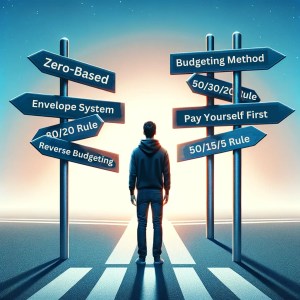- Unveiling the #1 Guide to Mastering Your Finances: Finding Your Perfect Budgeting System
- Introduction: Navigating the Path of Financial Mastery
- Types of Budgets: Pros and Cons Unveiled
- The Power of a Well-Crafted Budget: Illuminating Financial Security
- Beyond Expense Tracking: Crafting Your Strategic Roadmap
- The Shield Against the Unforeseen: Fortifying Your Financial Fortress
- Blueprint for Aspirations: Transforming Dreams into Reality
- Your Budget as a Guiding Partner
- 🌟 Not All Budgets Are Created Equal: Crafting a Personalized Financial Path 🌟
- 🎨 Types of Budgeting Methods: A Palette of Choices 🎨
- 🧩 The Zero-Based Budget: Unraveling Financial Puzzles
- 💵 The Envelope System (Cash-Stuffing): Tangible Spending
- 🌈 The 50/30/20 Budgeting Rule: The Art of Simplicity
- 💰 The Pay Yourself First or 80/20 Budget: Prioritizing Savings 💰
- 🎭 The Reverse Budgeting System: A Dance of Flexibility 🎭
- 🎼 The 50/15/5 Budgeting Rule: A Symphony of Allocations 🎼
- Common Budgeting Mistakes: The Pitfalls to Avoid 🚫
- Discovering Your Financial Path: Crafting Your Budgeting Blueprint
- Empowered Financial Freedom: The Culmination
- 🌟 Conclusion: Your Financial Odyssey Awaits
Unveiling the #1 Guide to Mastering Your Finances: Finding Your Perfect Budgeting System
🚀 Embark on a Financial Adventure: Unveiling the Secrets of Budget Mastery 🚀
Get ready to embark on a thrilling journey into the world of financial empowerment! In a landscape where financial uncertainty often feels like the norm and dreams seem distant, we’re here to light up the path ahead. Let’s dive deep into the world of budgeting – not just typical expense tracking, but a captivating adventure that leads you to newfound financial freedom.
In these times of rising prices and relentless inflation taking a toll on our wallets, budgeting has become a crucial aspect of our financial lives. To be frank, it’s always been a significant factor, but lately, I’ve truly felt its weight every time I stroll down the grocery store aisles to shop for my family. The cost of everyday items has skyrocketed, and it’s hitting us hard. It’s clear that living within our means is not just a choice; it’s a necessity for survival.
Moreover, it’s not just the groceries that are pinching our pockets. From fueling our cars to paying utility bills, the monthly expenses seem to be on a never-ending upward trajectory. It’s like a never-ending game of financial whack-a-mole, where as soon as you manage to balance one expense, another one pops up.
With this ongoing financial struggle, it’s crucial to become not just savvy but strategic with our budgeting. It’s no longer enough to simply track expenses; we need to plan ahead, make every dollar count, and explore creative ways to save. It might mean meal prepping at home more often, carpooling with friends or colleagues, or finding energy-efficient ways to keep our homes comfortable.
Ultimately, while the challenges of budgeting in today’s economic climate are undeniably daunting, it also presents an opportunity for personal growth and financial resilience. By mastering the art of budgeting, we can navigate these turbulent financial waters and ensure a more secure future for ourselves and our families.

Introduction: Navigating the Path of Financial Mastery
🚀 Embark on Your Financial Odyssey 🚀
Did you know that only 41% of Americans use a budget to keep track of their finances? If you’re not part of that statistic, you’re missing out on a transformative journey.
Get ready to unearth the brilliance of budgeting and unravel the mystery behind various budgeting methods. This isn’t just about numbers; it’s about crafting a personalized financial blueprint that propels you toward your dreams.
Fasten your seatbelts, because we’re diving deep into the world of budgeting. You’re not just going to navigate the twists and turns of financial life; you’re going to master them. So, are you ready to turn your financial dreams into reality? Let’s get started!
Types of Budgets: Pros and Cons Unveiled
🔍 Choosing the Right Budgeting System 🔍
Choosing the right budgeting system is like picking the perfect pair of running shoes. It has to fit well with your lifestyle, be comfortable for long-term use, and, most importantly, help you reach your financial finish line. Let’s delve into the pros and cons of popular budgeting methods to help you find your perfect fit.
Zero-Based Budget
🚀 Zero-Based Budget Pros and Cons 🚀
Zero-Based Budget Pros: Complete control over every dollar
Zero-Based Budget Cons: Time-consuming
The Zero-Based Budget is the Marie Kondo of budgeting methods. It assigns a purpose to every dollar, ensuring that your finances are as organized as your sock drawer. This method is perfect for those who love to micromanage their finances but can be time-consuming.
Check out this awesome Zero Based Budget planner on Amazon!

50/30/20 Rule
🚀 50/30/20 Rule Pros and Cons 🚀
50/30/20 Rule Pros: Simplicity and ease of use
50/30/20 Rule Cons: Less flexibility
If you’re looking for a budgeting method that’s as simple as a Sunday morning, the 50/30/20 Rule is your go-to. It’s straightforward but offers less flexibility, making it ideal for budgeting beginners or those who want a hands-off approach.
Here is a great planner to help you budget: Clever Fox Budget Planner
The Envelope System (Cash-Stuffing)
🚀 The Envelope System (Cash-Stuffing) Pros and Cons 🚀
The Envelope System Pros: Tangible and disciplined spending
The Envelope System Cons: Requires handling physical cash
The Envelope System brings budgeting into the tactile realm. It’s excellent for those who need to see and feel their money to manage it effectively. However, in a world moving towards digital transactions, handling physical cash can be a drawback.
Here is another great product on Amazon to help you stay organized: Clever Fox Cash Envelopes
Get your free credit scoreThe Pay Yourself First or 80/20 Budget
🚀 80/20 Budget Pros and Cons 🚀
80/20 Budget Pros: Prioritizes Savings
80/20 Budget Cons: Requires Discipline
This method is the financial equivalent of eating your vegetables before dessert. It prioritizes your financial future by allocating savings first. However, it requires a disciplined approach to manage the remaining 80% effectively.
Try out this awesome product on Amazon that makes your saving process more fun and rewarding: $20 Savings Challenge Tracker

The Reverse Budgeting System
🚀 The Reverse Budgeting System 🚀
The Reverse Budgeting System Pros: Flexibility
The Reverse Budgeting System Cons: Less structured
If you’re the kind of person who likes to color outside the lines, the Reverse Budgeting System offers the flexibility you crave. However, its less structured nature may not be suitable for everyone.
The 50/15/5 Budgeting Rule
🚀 The 50/15/5 Budgeting Rule Pros and Cons 🚀
The 50/15/5 Budgeting Rule Pros: Balanced approach
The 50/15/5 Budgeting Rule Cons: May not suit extreme financial goals
This method offers a balanced approach, allocating funds to essential expenses, retirement savings, and emergency funds. However, if you have extreme financial goals, like paying off a large debt quickly, this method may not be the best fit.
💡 Takeaway
Remember, the best budgeting method is the one that you will stick with. It should align with your financial goals and lifestyle. Don’t be afraid to mix and match methods or tweak them to better suit your needs.
The Power of a Well-Crafted Budget: Illuminating Financial Security
☀️ Emergence of a Financial Beacon ☀️
In a world where financial instability is all too common, a staggering 75% of Americans find themselves on the edge of economic uncertainty, living paycheck to paycheck. The gravity of this situation cannot be understated, as the specter of financial insecurity casts a shadow over aspirations and dreams.
- Navigating Economic Uncertainty: Living paycheck to paycheck has become the norm for many, emphasizing the importance of budgeting.
- Emergence of a Financial Beacon: A well-crafted budget shines as a beacon of empowerment and security amidst economic uncertainty.
Beyond Expense Tracking: Crafting Your Strategic Roadmap
💪 Empowering Financial Clarity 💪
A well-crafted budget is more than just tracking expenses; it’s a strategic masterpiece that allocates your earnings with precision. It transforms financial goals into actionable steps and empowers you to navigate the labyrinth of income and expenses.
- The Art of Allocation: Budgeting is more than tracking – it’s about strategic allocation that provides clarity and control.
- Empowering Financial Clarity: Your budget serves as a navigator through unpredictable financial waters, offering direction and control.

The Shield Against the Unforeseen: Fortifying Your Financial Fortress
😇 Budget as Your Guardian 😇
Life’s unpredictability demands a fortified defense. A well-constructed budget becomes your shield against the unforeseen, offering protection and resilience.
- Navigating Life’s Turmoil: Unexpected challenges are inevitable, but a budget provides a fortified defense.
- Budget as Your Guardian: Your budget safeguards your financial well-being, providing security during challenging times.
Blueprint for Aspirations: Transforming Dreams into Reality
📜 Creating Your First Budget: A Step-by-Step Guide 📜
Creating your first budget might feel like assembling a puzzle with a thousand pieces. Don’t worry; we’re here to guide you through each step, turning that intimidating jigsaw into a beautiful financial picture.
Crafting Your Budget: A Simplified Approach
Follow these steps to create a budget that works for you:
Step 1: Uncover Your Income Streams
Begin your budgeting journey by accurately assessing all your income sources. This includes not just your primary salary but also any additional earnings from side hustles, occasional windfalls like tax refunds, or even unexpected gifts. Understanding your total income is the foundation upon which your budget will be built.
Step 2: Chronicle Your Expenses
With your income in clear view, proceed to list all your expenses. Start this financial inventory with fixed costs such as rent, mortgage, or loan payments, and utilities. Then, account for variable expenses like groceries, leisure activities, and other lifestyle costs. This comprehensive expense mapping is crucial for informed budgeting.
Step 3: Prioritize and Allocate Funds
Now, prioritize your expenses. Essential needs like housing, food, and healthcare should take precedence. Next, earmark funds for savings goals, followed by discretionary spending. This step is about creating a hierarchy of financial priorities that aligns with your life goals and values.
Step 4: Set Inspirational Financial Goals
What’s the endgame of your budgeting? Is it a serene beach vacation, a new vehicle, or perhaps the lofty goal of financial independence? Setting clear, motivational goals gives your budget direction and purpose, transforming it from a mere financial tool to a roadmap for your aspirations.
Step 5: Monitor, Adapt, and Evolve
A budget is not a static entity; it’s a living part of your financial ecosystem. Regularly track your spending to ensure it aligns with your budget. Be ready to adapt your budget to life’s inevitable changes and surprises. This ongoing process of monitoring and adjustment is key to maintaining a budget that accurately reflects and supports your evolving financial landscape.

Turning Dreams into Tangible Achievements with Our Budget Creation Checklist!
🎁 Downloadable Budget Template 🎁
To make your budgeting journey even easier, we’re offering an exclusive downloadable budget template for our readers. View More Here!
Your Budget as a Guiding Partner
🛠 Dynamic Blueprint for Financial Success
Creating your first budget might feel like assembling a puzzle with a thousand pieces. Don’t worry; we’re here to guide you through each step, turning that intimidating jigsaw into a beautiful financial picture.
🌟 Not All Budgets Are Created Equal: Crafting a Personalized Financial Path 🌟
Unlocking Your Budget’s Full Potential
Just as each person’s financial journey is unique, so should be the guiding budget. The true power of budgeting is unleashed when it aligns precisely with your objectives and lifestyle. The one-size-fits-all approach falls short; finding a budgeting method that deeply resonates with your values and goals is key.
However, not all budgets are equal. Just as each person’s financial journey is unique, so should be the guiding budget. The true power of budgeting is unleashed when it aligns precisely with your objectives and lifestyle. The one-size-fits-all approach falls short; finding a budgeting method that deeply resonates with your values and goals is key.

🧭 Your Budget as a Guiding Partner
As you venture into financial empowerment, remember that your well-constructed budget serves as your guiding compass. It navigates through turbulent financial waters, steering you toward security and accomplishment. Beyond numbers, your budget instills control, purpose, and confidence. It transforms financial uncertainty into stability and dreams into reality. It’s more than a tool; it’s a partner on your path to a brighter financial future.
🎨 Types of Budgeting Methods: A Palette of Choices 🎨
🧩 The Zero-Based Budget: Unraveling Financial Puzzles
Imagine your finances as a complex puzzle – the zero-based budget assigns purpose to every dollar, assembling a comprehensive financial picture. This meticulous allocation offers unparalleled visibility, preventing funds from slipping through unnoticed gaps.
🛡️ Including the Emergency Fund
Integral to this budget is the emergency fund. It’s your lifeline during unpredictable financial storms, guarding against unexpected expenses, medical emergencies, and job loss. Allocating part of your budget to this safety net ensures preparedness, providing stability even in turbulent times.
📝 Practical Tips:
- List all sources of income and allocate them to specific categories, such as bills, savings, and discretionary spending.
- Prioritize building an emergency fund that covers at least three to six months’ worth of expenses.
- Regularly review and adjust your budget to accommodate changes in income or expenses.
💵 The Envelope System (Cash-Stuffing): Tangible Spending
Bringing Tangibility to Your Budget
The envelope system takes your financial strategy into the realm of tactile experience. Especially effective for curbing impulsive spending habits, this method employs envelopes for each spending category. Once the envelope is empty, spending in that category stops until the next budgeting cycle.
🌿 Fostering Discipline and Mindful Consumption
This direct approach cultivates disciplined spending habits and heightens awareness of financial decisions. The envelope system not only prevents overspending but also encourages mindful consumption. Handling physical cash establishes a tangible link between purchases and money, enhancing accountability and control.
📝 Practical Tips:
- Identify key spending categories, such as groceries, entertainment, and dining out.
- Allocate cash to each envelope based on your budget for that category.
- Once an envelope is empty, refrain from spending in that category until the next budget cycle.
🌈 The 50/30/20 Budgeting Rule: The Art of Simplicity

🌟 Simplicity in Budgeting
The 50/30/20 budgeting rule appeals to those who cherish simplicity. It offers a straightforward framework that divides income into three categories: needs, wants, and savings/debt repayment.
Needs (50%): Cover essential expenses like housing, utilities, groceries, transportation, and insurance. This allocation ensures fundamental needs are met while allowing financial flexibility.
Wants (30%): Embrace discretionary spending, including dining out, entertainment, hobbies, and non-essential shopping – things that bring joy to life.
Savings/Debt Repayment (20%): Allocate this portion to savings, investments, and debt repayment. Prioritize your financial future, whether through emergency funds, retirement accounts, or reducing debt.
📊 Striking Balance between Discipline and Pleasure
The 50/30/20 rule harmonizes disciplined financial planning with the freedom to enjoy life’s pleasures.
📝 Practical Tips:
- Determine your after-tax income and allocate 50% to necessities (rent, utilities, groceries), 30% to wants (dining out, entertainment), and 20% to savings or debt repayment.
- Regularly review your spending to ensure you’re staying within the allocated percentages.
- Adjust your budget as your financial goals evolve.
💰 The Pay Yourself First or 80/20 Budget: Prioritizing Savings 💰
🌟 Emphasis on Your Financial Future
The pay yourself first or 80/20 budgeting method centers on prioritizing your financial future. Even before allocating funds to other categories, you commit a portion of your income – typically 20% – to savings, investments, or debt repayment. This ensures that your financial aspirations take precedence over discretionary spending.
Strength in Building an Emergency Fund and Tackling Debt
This approach proves invaluable for establishing an emergency fund or aggressively addressing debt. By giving priority to savings, you solidify your financial base and set a course toward long-term security.
While demanding discipline, the pay yourself first method lays the foundation for achieving financial goals with clarity and purpose.
📝 Practical Tips:
- Set up automatic transfers to a separate savings account before allocating funds to other categories.
- Start with allocating 20% of your income to savings and adjust as needed.
- Use the remaining 80% for bills, expenses, and discretionary spending.
🎭 The Reverse Budgeting System: A Dance of Flexibility 🎭

🌟 Flexibility and Empowerment
The reverse budgeting system is a refined version of the pay yourself first approach, marked by its adaptability and empowerment. In this method, you allocate a fixed percentage of your income – often 20% – to savings, investments, and debt reduction. However, unlike funneling this percentage into a single financial objective, you distribute it among diverse goals each month.
Balancing Financial Responsibility and Freedom
This flexibility empowers you to simultaneously pursue various financial aspirations. Whether it’s building an emergency fund, financing a vacation, or contributing to retirement, the reverse budgeting system harmonizes financial responsibility with the liberty to pursue multiple objectives.
📝 Practical Tips:
- Define your financial goals, such as saving for a vacation, retirement, or a down payment.
- Allocate a percentage of your income to each goal and create separate savings accounts.
- As your goals evolve, adjust the percentages and contributions accordingly.

🎼 The 50/15/5 Budgeting Rule: A Symphony of Allocations 🎼
🌟 Prioritizing Financial Control with Different Emphases
The 50/15/5 budgeting rule offers a clear roadmap for financial well-being, prioritizing both present needs and future security.
Similar to the 50/30/20 rule, the 50/15/5 budgeting rule offers a simplified path to financial control while highlighting distinct priorities. In this allocation strategy:
Essential Living Expenses (50%): Half of your income is dedicated to covering necessities such as housing, utilities, groceries, transportation, and insurance. This ensures that your fundamental needs are met without financial strain.
Retirement Savings (15%): This category focuses on securing your financial future by directing 15% of your income towards retirement accounts like 401(k)s or IRAs. Consistently contributing to retirement funds prepares you for a comfortable retirement and long-term financial stability.
Short-Term Emergency Funds (5%): The remaining 5% is allocated to creating a cushion for unexpected expenses. This fund safeguards against sudden financial shocks, providing peace of mind and preventing the need to dip into other areas of your budget.
The 50/15/5 budgeting rule offers a clear roadmap for financial well-being, prioritizing both present needs and future security.
📝 Practical Tips:
- Allocate 50% of your income to essential living expenses, such as housing and groceries.
- Dedicate 15% to retirement savings or investments for long-term financial security.
- Set aside 5% for short-term emergency funds to handle unexpected expenses.
Common Budgeting Mistakes: The Pitfalls to Avoid 🚫

The Road to Financial Freedom is Paved with Good Intentions… and a Few Potholes
While budgeting can be your ticket to financial freedom, it’s not without its challenges. Even the most well-intentioned budgeters can fall into common traps that hinder their progress. Let’s shine a light on these pitfalls so you can steer clear.
1. Overestimating Income 💸
Optimism is great, but overestimating your income can lead to spending money you don’t actually have. Always budget based on your net income, not your gross income or potential bonuses.
2. Underestimating Expenses 🛒
It’s easy to forget about those small, recurring expenses that add up over time. Make sure to account for everything, from your Netflix subscription to your morning coffee.
3. Ignoring Savings 🏦
Savings aren’t just for a rainy day; they’re an integral part of financial wellness. Neglecting to save can leave you vulnerable in emergencies and unprepared for future goals.
4. Failing to Adapt 🔄
Life is unpredictable. Your budget should be flexible enough to adapt to life changes such as a new job, unexpected expenses, or changes in your financial goals.
5. Not Tracking Spending 📊
What’s the point of a budget if you’re not going to track your spending? Regularly reviewing your expenses ensures you’re sticking to your budget and allows for adjustments as needed.
Recovery Tips
If you’ve fallen into any of these traps, don’t despair. The key is to acknowledge the mistake, adjust your budget, and move forward. Remember, the journey to financial freedom is a marathon, not a sprint.
Discovering Your Financial Path: Crafting Your Budgeting Blueprint

🥅 Aligning Your Budget with Aspirations 🥅
At the core of triumphant budgeting lies the alignment of your budget with your dreams. Whether you’re focused on annihilating debt, building an emergency fund, or embarking on a long-awaited vacation, your aspirations determine your budget’s trajectory. Begin by closely examining your spending patterns to uncover your financial tendencies. This baseline forms the foundation for constructing a budget that mirrors your reality. Remember, budgeting is not one-size-fits-all; experimentation can be your best guide.
Empowered Financial Freedom: The Culmination
🗽 Guided Towards Financial Liberation 🗽
In a realm of boundless financial possibilities, your budget becomes your ally, directing you towards the realms of financial liberation. By selecting a budget that resonates with your objectives and lifestyle, you embark on a transformative journey – one where your money’s direction aligns with your ambitions. Whether you thrive on meticulous planning or embrace adaptable spending, the right budgeting system unlocks the gateway to a brighter financial horizon. The journey beckons – take the plunge and witness your financial dreams metamorphose into reality.

Join the Conversation: Simply Sound Society Forum
As you embark on your journey to financial mastery, remember that you’re not alone. Our Simply Sound Society forum is a bustling community where like-minded individuals gather to share insights, experiences, and support each other on their financial odysseys.
Whether you’re a budgeting novice or a seasoned financial planner, the Simply Sound Society forum is your go-to destination for vibrant discussions, practical advice, and a sense of camaraderie. Here, you can:
- Share your budgeting success stories and learn from others’ experiences.
- Get answers to your pressing financial questions from peers and experts alike.
- Discover unique budgeting tips and hacks that you won’t find anywhere else.
- Connect with a supportive community that encourages and motivates each other towards financial well-being.
Engage, Learn, and Grow with Us
Your voice matters in the Simply Sound Society. By sharing your journey and learning from others, you amplify your financial wisdom and contribute to a community that thrives on mutual growth and support. Join the conversation today and take your financial odyssey to new heights!

🌟 Conclusion: Your Financial Odyssey Awaits
Guiding Your Financial Voyage Towards Achievement
Charting Your Financial Voyage Towards Achievement
Your budget is more than a mere tool; it’s your guiding compass in the intricate labyrinth of income and expenses. By selecting a budgeting method that resonates with you, you’re not just managing currency—you’re crafting your financial narrative.
In a world brimming with financial opportunities, your budget stands as the vessel steering you towards the shores of fiscal accomplishment. As you’ve delved into the intricacies of various budgeting methods, you’ve uncovered a treasure trove of tools capable of shaping your financial destiny.
Remember, your budget is a living, breathing entity. It’s a dynamic blueprint that should evolve as your financial goals and circumstances change. It empowers you to seize control of your money, navigate through financial waters, and steer toward your dreams.
TRY OUR FREE DAILY LIVING EXPENSES CALCULATOR TODAY!
The path to financial freedom is not a straight line; it’s a journey filled with learning, growth, and occasional course corrections. Your budget serves as your steadfast companion, offering guidance and stability even amidst uncertainty.
What’s Next?
Stay tuned for our next article where we’ll dive into the art of debt management. Learn how to tackle debts head-on and free yourself from the shackles of financial burden.
Debt Management Tips: Your Path to Financial Freedom
With a budget finely attuned to your goals and lifestyle, you transition from following money to leading it. This journey is one of transformation, where your financial dreams undergo metamorphosis into reality. Through informed decisions, progress tracking, and adaptation to life’s twists and turns, you cultivate a profound understanding of your financial landscape.
Do not forget to check out all of our exciting free tools! Calculators, quizzes and downloadable checklists all for free.

















